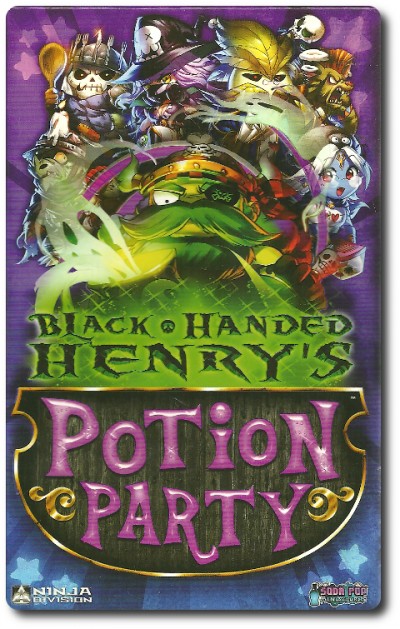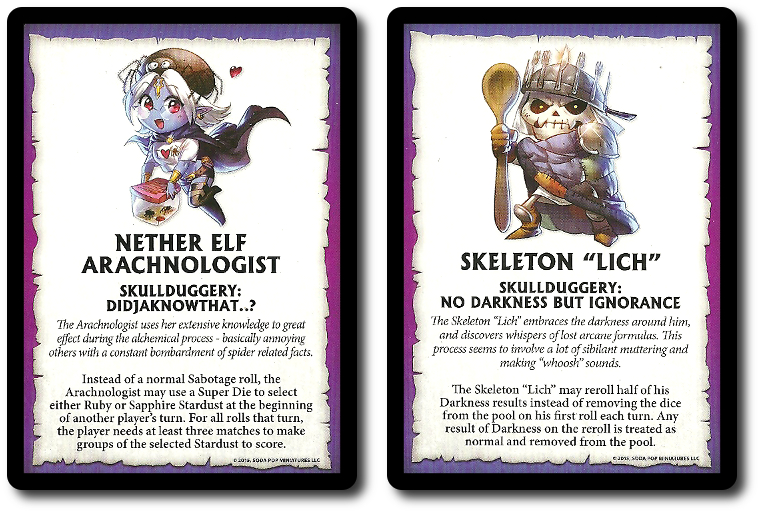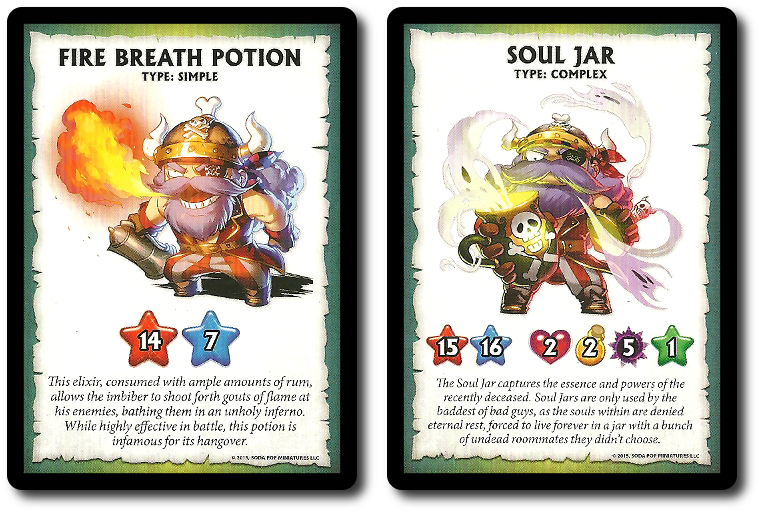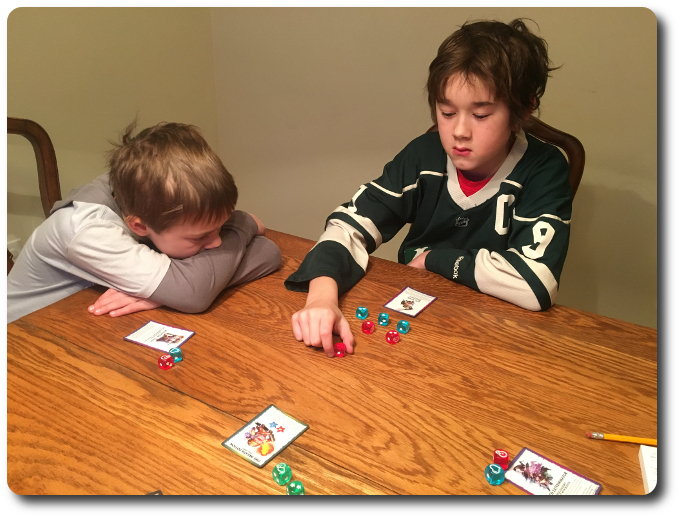
The Basics:
- For ages 6 and up (publisher suggests 7+)
- For 2 to 4 players
- Approximately 20 minutes to complete
Geek Skills:
- Active Listening & Communication
- Counting & Math
- Logical & Critical Decision Making
- Reading
- Pattern/Color Matching
- Risk vs. Reward
- Hand/Resource Management
Learning Curve:
- Child – Easy
- Adult – Easy
Theme & Narrative:
- Survive the night by quenching Black-Handed Henry’s thirst!
Endorsements:
- Gamer Geek rejected!
- Parent Geek approved!
- Child Geek approved!
Overview
Black-Handed Henry is a dangerous and unstable person. He’s made his living being a terror at sea and he is used to getting his way. Right now, he only has one thing on his mind: a potion. He growls at you saying, “Listen ‘er, you grubby maggots. I have a terrible thirst! Brew me my potion and you live! Fail and I toss you overboard!” Now that’s what I call motivation!
Black-Handed Henry’s Potion Party (Potion Party for short), designed by Tony Marsters and published by Ninja Division, is comprised of 8 Alchemist cards, 8 Potion cards, 8 Sapphire dice (blue), 6 Ruby dice (red), and 2 Emerald dice (green). The cards are a thick and as durable as your standard playing card. The dice are the same found in the game Super Dungeon Explorer, on which Potion Party is based. Not included with the game, but necessary to play, is some sort of method of keeping track of individual player’s progress towards completing potion recipes. I suggest a pad of paper and a pen or pencil, but tokens will do (such as those found in Super Dungeon Explorer).
Note: You do not need to know anything about or have previously played Super Dungeon Explorer to play this game.
Captured by Black-Handed Henry
To set up the game, first have each player roll 2 Sapphire dice. The player who rolls the most stars will be the First Player for the duration of the game.
Second, starting with the First Player and continuing in turn order sequence, each player selects 1 Alchemist card and places it in front of them, face-up. Place any Alchemist cards not selected back in the game box.
Third, the last player to select an Alchemist card now selects the Potion Recipe card that will be used for the duration of the game. Potion Recipes come in various degrees of difficulty, with the more difficult recipes requiring more components to complete. If this is the players’ first game or a shorter game is required, a simple Potion Recipe card should be selected. Place any Potion Recipe cards not used back in the game box. The selected Potion Recipe card is placed face-up in the middle of the playing area.
Fourth, place all the dice next to the Potion Recipe card.
That’s it for game set up. Time to brew a potion.
Fire Burn and Cauldron Bubble
Potion Party is played in turns with no set number of turns per game. A player’s turn is summarized here.
Step 1: Roll Dice
A player will always roll 3 Sapphire (blue) and 3 Ruby (red) dice by default. During the game, they might be able to roll more on their turn. If they do have more dice, they add them to the 3 Sapphire and 3 Ruby dice now. All dice are rolled in front of the player and remain visible to opponents.
Different colored dice have different odds of rolling specific values. In addition, certain values can only be found on 1 specific dice color. Players should keep this in mind when determining what dice to roll in the game. Doing so will allow them to better calculate their odds of success.

Step 2: Remove the Darkness
If any dice rolled result in a blank, referred to as “Darkness”, they are set aside and are considered out of play for the duration of the player’s turn. Players can move these back to the middle of the playing area to help them keep track of what dice are available and what dice are not.
Step 3: Collect Ingredients
Ingredients in the game are collected by grouping 2 or more matching number of stars on dice that are also the same color. This creates stardust. The number of stars and the dice color equals the amount and color of the stardust. The number is recorded and the dice used are no longer usable by the player. They are kept as a group and set to one side until the player’s turn is over.

Players can also match a “Potion” Ruby die with a “Heart” Sapphire die to create an Emerald (green) die. The Ruby and Sapphire die are moved back to the middle of the playing area. The Emerald die, also referred to as a “Super Die”, is placed next to the player’s Alchemist card. The player can now do one of the 2 following actions with the Emerald die.
- Save the Emerald die for Sabotage later during their turn (explained below).
- Roll the Emerald die right away. Any stars rolled are “wild” and can represent Sapphire, Ruby, or Emerald. The player need not match it to any other die to collect the stardust for potion creation. If a “Heart” and “Potion” is rolled, the player can decide to use it as a “Potion” Ruby or a “Heart” Sapphire. Either way, the Emerald die is then placed back in the middle of the playing area.
Any “Potion” Ruby dice and “Heart” Sapphire dice not matched to create an Emerald die can be kept by the player as Alchemy components. The dice are placed on the player’s Alchemist card and can be rolled later in the game, adding additional dice to the starting number of dice to be rolled. Players can never save dice, however, if it would cause less than 3 Ruby and 3 Sapphire dice to be available for the next player.
Step 4: Push Your Luck or End Your Turn
A player can end their turn now and keep all the stardust and dice they earned. The stardust the player earned is recorded. If the player has an Emerald die, they can now attempt to Sabotage an opponent (see below).
If the player likes, they can keep rolling. Any dice not used to create stardust can now be rolled again. The process of sorting and scoring the dice is repeated. Any stardust collected or dice created are added to whatever the player previously had. New stars can be added to previously created groups to create even more stardust. The player can then decide to continue to roll or end their turn.
If the player does not match any dice to previously created dice groups on their turn when rolling a second time, they lose all the stardust they earned during their previous rolls. This only impacts the points earned during the player’s current turn. Previous stardust earned is safe, as are any Emerald dice and Alchemy dice. Unless the player wants to roll again, the players turn is now over.
The next player in turn order sequence now takes their turn.
Sabotage and Skullduggery
A player can Sabotage an opponent at the end of their turn if they have an Emerald die. The die is rolled and star results can be of any die type with the number of stars shown. The player then points to one opponent who is now Sabotaged. The opponent reduces their current number of collected stardust by the number and type the player indicates, per the value rolled on the Emerald die. The Emerald die is then placed back in the middle of the game playing area. A roll of a “Heart” and a “Potion” indicates that the Sabotage failed and the Emerald die is placed back in the middle of the playing area.
All Alchemist cards list a special Skullduggery ability that is unique to the Alchemist on the card. The abilities are triggered when certain conditions are present in the game. It’s up to the player to recognize the required condition and announce that their Alchemist’s Skullduggery ability can be used. The ability is read out loud and immediately resolved. Game play then resumes. There is no limit to the number of times a Skullduggery ability can be used during the game, but it can only be used when the game conditions allow it.

Potion Perfection!
The game continues until 1 player has successfully collected the ingredients necessary to brew the Potion card. The simpler Potion cards will only require a specific number of collected Ruby and Sapphire stardust. More complex Potion cards include additional dice rolls that must be set aside if the potion is to be created. The more complex ingredients can only be recorded after the player has collected enough Ruby and Sapphire stardust.

The first player to successfully brew the potion wins!
House Rules
We created 1 House Rule while playing this game. This created a game variant that is not part of the standard rules. Feel free to use it if you like.
No Sabotage Allowed
The game can be difficult enough trying to roll specific values and collect enough stardust. The Sabotage rule allows players to remove stardust from opponents, thus allowing others to catch up or to fall behind. This rule was found to be too distracting and unnecessary by many of our players. At their suggestion, we removed the Sabotage rule and action option from the game. The end result was a game where players could keep what they rolled and took bigger chances in hopes of making up for short stardust counts.
To learn more about Black-Henry’s Potion Party, visit the game’s web page.
Final Word
The Child Geeks really enjoyed themselves. A very small handful had heard of and played Super Dungeon Explorer. These Child Geeks all agreed that Potion Party was nothing like the board game, but that didn’t matter. According to one Child Geek, “This is a fun game. I like games like this because they are fun and can be really exciting!” Exciting and disappointing. According to one Child Geek, “The only bad part about this game is that you can lose just because the dice don’t land right.” Very true, but this unfortunate possibility was universally accepted by the Child Geeks. It wasn’t the chance of not getting anything that was on the Child Geeks’ minds, but the chance of getting everything. When the games were over and the potions brewed, the Child Geeks all agreed that the game was a keeper. They weren’t sure of the Sabotage rule, however.

Downtime was kept to a minimum, but the Child Geeks were still impatient for their next turn
The Parent Geeks also had a good time. Dice and luck are a great equalizer when it comes to ensuring that a player with more skill and experience doesn’t have an advantage over others. The game leveled the playing field and each player was held hostage by the same dice that sometimes rolled right and sometimes rolled wrong. According to one Parent Geek, “Games like this are fun to play with the kids. No matter how hard I might try to beat them, they have the same chance of beating me.” Another Parent Geek said, “The unique characters and more complex Potion Recipes are fun to use. It makes the game more cutthroat, in a way, and I find myself taking more chances.” The game was found to be fun not only with the family, but also among non-gamer and casual Parent Geeks when playing with their peers. Even the more experienced Parent Geeks found the game to be entertaining. The final vote resulted in an approval from the Parent Geeks.
The Gamer Geeks appreciated what the game was about, but not how it played. According to one Gamer Geek, “Dice games like this can be fun, but only on really rare occasions when I have absolutely nothing else going on.” Another Gamer Geek said, “This plays like ever other risk-taking dice-rolling game I have ever played. The only difference is the Alchemists, but even that has been done before. The game is OK, I guess, but not that interesting to me.” The Gamer Geeks didn’t find anything wrong with Potion Party, and even went to so far as to say it was a “well made game” and would be “fun with the right crowd”, but they did not endorse it. They found Potion Party to be too random for their taste and politely excused themselves from playing more games.
Potion Party, like pretty much every dice-rolling push-your-luck game available, is light, fast, and meant to be casual and fun rather than serious and deep. The goal is to get the players to play a game while they are waiting to play other games or only have time to play 1 game with friends. The amount of thought that is necessary in the game is limited to deciding if what you rolled is good enough or if you should roll a bit more. There is a strong risk versus reward element to the game that encourages players to take a chance. Outcomes range from spectacular rolls to legendary failures.
I am not a fan of the Sabotage rule as it makes the game unnecessarily longer. We played it with and without the Sabotage rule and its use in the game always came down to player preferences. Some players liked a game where they could slap opponents figuratively in the cheek, while others passionately did not. Luckily, removing the Sabotage rule does not bend or break the game in any way. Heck, it might even have saved a few friendships.
On the other hand, I love the Skullduggery. It gave each player a unique rule and advantage. While the Skullduggery abilities didn’t add much in the way of tactical or strategic play, it did give each player a special ability that set them apart.
According to the Gamer Geeks, Potion Party is not a game that any “serious” gamer would enjoy. I agree that the game is light and random, but I disagree with their assertion that gaming enthusiasts would not derive joy from Potion Party. Simple it may be, but it’s also fast and competitive. There is enough player interaction in the game, even without Sabotage in use, to make it a game perfect for bragging, sarcasm, flippant table talk, and high-fives. It’s a game that is meant to let the players enjoy themselves, their company, and just because it’s there, the game.
I have played games that take days, consider myself a gaming elitist, and am even a snob at times. I say this because I enjoyed Potion Party. It was nothing but fun. What it lacked was tactical and strategic play. What it required was critical and logical thinking. But more importantly, it challenged me to play the odds, reach for something greater than what I rolled, and give the finger to chance to embrace the rush of taking a risk. Not bad for a little game that is played by rolling dice at the table.
If you enjoyed games that can be played easily with friends that have a diverse gaming background and skill set, where taking a risk is all part of the fun, and the tension to excel and exceed never lets go, then do play Back-Handed Henry’s Potion Party.
This game was given to Father Geek as a review copy. Father Geek was not paid, bribed, wined, dined, or threatened in vain hopes of influencing this review. Such is the statuesque and legendary integrity of Father Geek.



